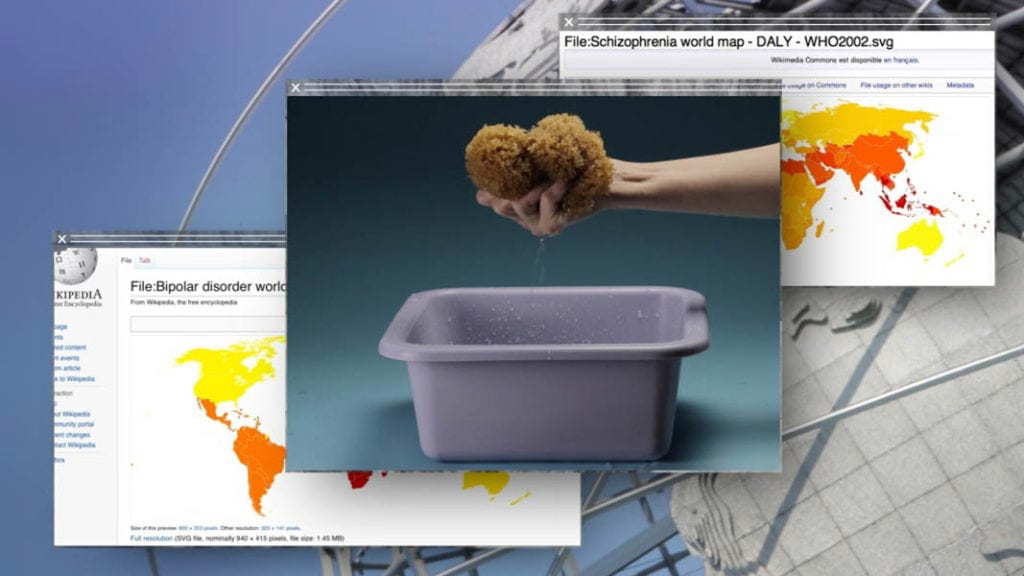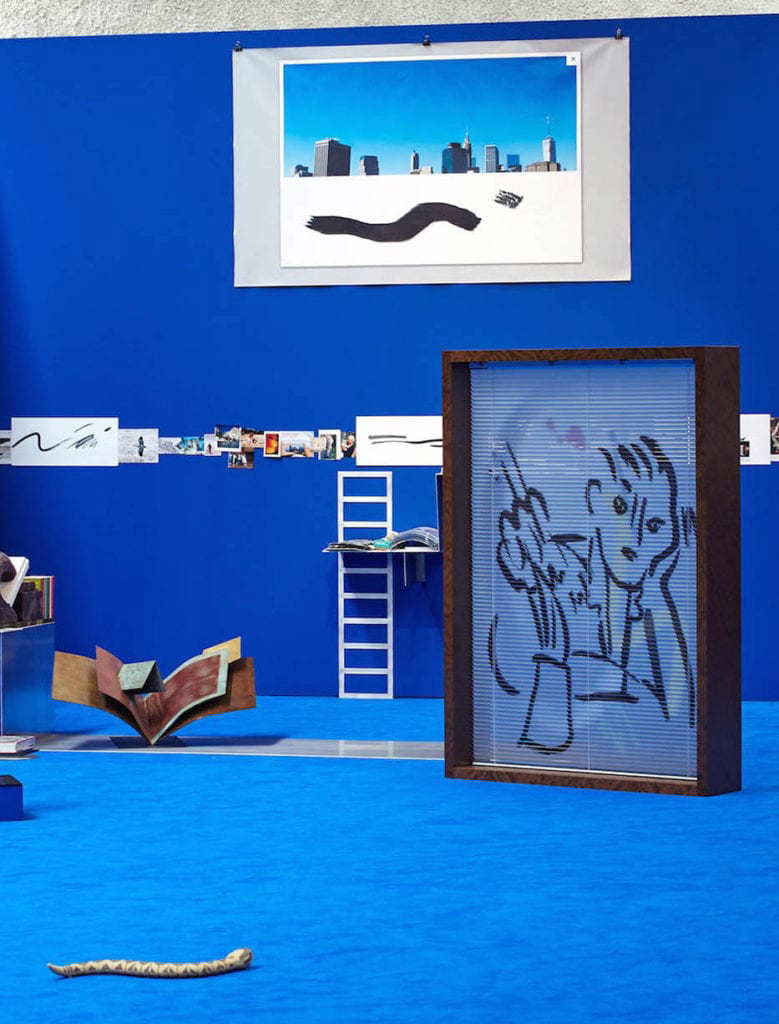
Camille Henrot is one of the big shooting stars in the contemporary art scene – at least since she has won the prestigious Silver Lion Award at the 55th Venice Biennale in 2013 for her video installation Grosse Fatigue. However, the artist doesn’t fulfill the clichés of an internationally known contemporary artist: eccentric, provocative, loud. On the contrary, when you see Henrot giving an interview, she is rather reserved. She chooses her words carefully. She is an observer, a narrator. As the Guggenheim Museum puts it, Henrot conflates the roles of artist and anthropologist, thus creating art that is born out of an intensive research process.

In 2011, Henrot explained to French culture magazine Inrocks that the driving force behind her artworks is curiosity. She likes to emerge herself into the vast pool of knowledge, trying to make sense of it without judging. As a result, Henrot’s rich artworks are full of hidden narratives. At the same time, they evoke an atmosphere of elegance, subtlety and mythology. It is only after a closer look at her works that one will understand how she has successfully combined seemingly contradictory ideas, exploring the history of the universe, the nature of myth, and even the limits of human knowledge. Thus, what makes Henrot unique is her ability to express complex and existential themes through the use of multiple media and by creating beautiful and immersive environments.
Who Is Camille Henrot?

Camille Henrot was born in 1978 in Paris. She studied at the famous École nationale supérieure des arts décoratifs (ENSAD). Her first collective exhibitions took place in 2002 and she was then discovered and since represented by the kamel mennour gallery. In 2010, she was nominated for the Marcel Duchamp Prize. Since 2012, she has been working between New York and Paris as an artist resident. In 2013, she received a scholarship from the Smithsonian Institution in Washington D.C.
Get the latest articles delivered to your inbox
Sign up to our Free Weekly NewsletterAs part of this scholarship, Henrot achieved her artistic breakthrough: the institution gave her access to one of the most important databases in the world, an online encyclopedia devoted to biodiversity and the description of all species. As an extension of her work within the institution, Henrot realized a project for the 2013 Venice Biennale with the title The Encyclopedic Palace. She was entrusted by Massimiliano Gioni, curator at the New Museum in New York and curator of the biennale, to create a contribution revolving around encyclopedic knowledge. Thus, she created a video on the origin of the universe, called Grosse Fatigue.
Grosse Fatigue (2013)

In the beginning there was no earth, no water – nothing. There was a single hill called Nunne Chaha.
In the beginning everything was dead.
In the beginning there was nothing; nothing at all. No light, no life, no movement no breath.
In the beginning there was an immense unit of energy.
In the beginning there was nothing but shadow and only darkness and water and the great god Bumba.
In the beginning were quantum fluctuations.
Excerpt from Grosse Fatigue, source camillehenrot.fr
With Grosse Fatigue, Henrot set herself the challenge of telling the story of the universe’s creation in a thirteen minutes video. It is, indeed, a task that is impossible to fulfill. But the title of her work reveals the artist’s true intention: Her film is about exhaustion. It is about carrying a weight that is so huge, one fears to be crushed by it. Thus, Grosse Fatigue doesn’t purport to produce any objective truth about the universe’s creation. It is not about trying to fully comprehend an infinite mass of tiny information pieces. Henrot rather tries to explore the limits of organizing information and of the desire to universalize knowledge. With her work, she wants to convey what Walter Benjamin, using psychiatric terms, called a “cataloguing psychosis”.

To achieve this, Henrot applied the principle of analogical thinking: in her video, she alternates a large number of fixed or animated images which overlap like browser windows on a computer wallpaper. She uses images of animals or plants, anthropological objects or tools, scientists at work or historical moments. In doing so, Henrot performs what she calls an “intuitive unfolding of knowledge” through a series of shots that she has partly discovered in the prestigious collections of the Smithsonian Institution. Those shots have been reworked with images found on the internet and scenes filmed in diverse locations. Finally, the imagery is accompanied by sound and a text written in collaboration with Jacob Bromberg. The spoken word artist Akwetey Orraca-Tetteh recites the text which is inspired by various creation stories in an oratory manner. In combination – imagery, sound and text – Henrot’s video is overwhelming and oppressing, putting its viewers into a state of “grosse fatigue”. However, Henrot has not only constructed a rich and heavy multimedia narrative with her film: Grosse Fatigue also conveys a sense of subtleness and mysticism. The vivid colors of the imagery and the use of popular creation stories induce a sens-e of lightness and bubbliness. Thus, it is one of those artworks that will leave you feeling perplexed and bare in a very familiar way, without really knowing why.
The Pale Fox (2014)

The Pale Fox is an immersive environment built on Henrot’s previous project Grosse Fatigue: it is a meditation on our shared desire to understand the world through the objects that surround us. As Henrot explains on her website: “The main focus of The Pale Fox is obsessive curiosity, the irrepressible desire to affect things, to achieve goals, to perform actions, and the inevitable consequences.”
In this work, commissioned and produced by Chisenhale Gallery in partnership with Kunsthal Charlottenborg, Bétonsalon, and Westfälischer Kunstverein, Henrot realizes what she knows to do best: she works with multiple media, using more than 400 photographs, sculptures, books and drawings – mostly bought on eBay or borrowed from museums, others found or even produced by the artist herself. With that almost infinite amount of accumulated material, she is able to combine contradictory ideas in a complex and, at the same time, seemingly harmonious way. The artefacts populate a space that is both physical and mental, conveying a strangely domestic and thus familiar atmosphere: The Pale Fox could be a room that one could inhabit.

However, Henrot superimposes the familiarity of the environment by the idea of an excess of principles, for example the cardinal directions, the stages of life and Leibniz’s philosophical principles. Henrot has tried to apply those principles in order to organize the objects, ending up creating the overwhelming physical experience of a sleepless night. There is, after all, no harmony without disharmony – an insight that is at the very basis of Henrot’s artwork. Again, it’s the artwork’s title that best indicates what the artist is trying to convey: the Pale Fox is, for the West African Dogon people, the god Ogo. In the myth of origins, the Pale Fox embodies an inexhaustible, impatient, yet creative force. Henrot says: “This is what I’m drawn to in the figure of the fox: it is neither bad, nor good, it disturbs and alters a seemingly perfect and balanced plan. In that sense, the fox is an antidote to the system, acting on it from inside.”
With The Pale Fox, Henrot succeeds to set philosophy against pop culture and mythology against science within a space that conveys a misleading sense of harmony and familiarity. Thus, just as in Grosse Fatigue, she succeeds to create a numbing feeling of being deeply perplexed by her artwork without really understanding why.

Between 2017 and 2018, Henrot exhibited a Carte Blanche at the Palais de Tokyo in Paris, titled Days are Dogs. She included The Pale Fox in order to explore the narrative behind “the week” – one of the most foundational structures that organizes our lives. She used her installation to illustrate the last day of the week – Sunday – as the moment when the world’s intimate sequencing reflects the breadth of the universe.
The Artist Will Be Present

Henrot’s artworks are timeless and contemporary at the same time. This is due to her insatiable curiosity and her passion for trying to make sense of the metaphysical. While she is open to explore and master different media ranging from film to assemblage, sculpture and even Ikebana, she is also drawn to the universal themes that are at the very core of human existence. At the same time, Henrot is a master in wrapping up complex ideas elegantly, creating subtle and mystical atmospheres that are sweet enough we can’t help but immerse in them.
These are all indicators that Henrot is an artist that will remain with us in the future. She is not just a one-hit-wonder and her name will most certainly appear in the art history books of the future.

Along the Silver Lion at the Venice Biennale 2013, Henrot has also received the Nam June Paik Award in 2014 and is the 2015 recipient of the Edvard Munch Award. Furthermore, she has had numerous solo exhibitions in international institutions, including: Kunsthalle Wien (Vienna, 2017), Fondazione Memmo (Rome, 2016), New Museum (New York, 2014), Chisenhale Gallery (London, 2014 – first iteration of the touring exhibition “The Pale Fox”). She has participated in the Lyon (2015), Berlin and Sydney (2016) biennials and is represented by kamel mennour (Paris/London), König Galerie (Berlin) and Metro Pictures (New York).







